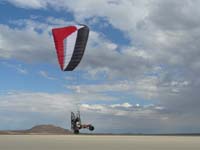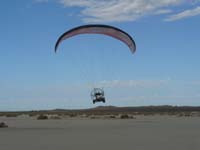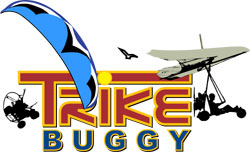Taxiing Techniques
In the trike, we must balance the glider and be sure to inspect the glider for sticks and line tangles before committing to the launch. Therefore, we will be focused on an activity we call "TAXIing" or rolling along after inflating and bringing the glider overhead.
 Staying directly under the glider in perfect balance will require: Staying directly under the glider in perfect balance will require:
- Looking up at your glider or using a mirror to see your glider overhead.
- Steering the glider using the brake toggles.
- Steering the trike with your feet to follow the glider and keep it centered.
This is the most important skill to master before we begin flying. We must settle and balance the wing while rolling along at midrange power to be able to continue into a launch and flight.
- Contact - The Taxi begins with Contact. After the inflation, when the glider is overhead and you can see it in the mirror, release the A's and apply contact to the brakes (bring them down immediately to your chest, then ease them up slowly to the trim position). Continue checking it to stay directly below the center while easing the throttle to about 2/3 or use Flutter Throttle technique - just enough to keep the forward motion necessary to keep the wing overhead, but not enough to launch. Be careful - deep toggle control will result in overcontrol!
- Inspect the Glider - Make sure there are no sticks or knots in the lines and that everything is free and clear. If there is any problem immediately pull the brakes down as far as you can and stop the engine. This will bring the glider back to the ground.
- Taxi - If everything is clear, then keep taxiing along your runway. Use short, quick downward pulls on the brakes and gentle foot steering to keep the paraglider overhead as you taxi. You must keep looking at your glider in the mirror! There is no way to "feel" the glider in the trike, and if you do not continue checking that you are balanced while TAXIing, the wing will soon be off to the side. If this continues, the wing will suddenly roll the trike over onto its side, potentially damaging you and the motor.
- Jab the Glider - On the ground, it is often better to give a quick "jab" to the glider to correct it rather than a prolonged, deep brake input. Holding the brake for more than a second or two will often shoot the glider sideways like a stretched rubberband!
- Steer the Wing, Follow with the Trike - Whenever you want to make a turn during taxiing, you must first steer the glider, then follow it with the trike, correcting the balance by bringing the trike back under the glider. In contrast, we cannot simply steer the glider back overhead if we have moved the trike out of balance from under the wing. Steer the trike where you want to go, and you will quickly imbalance the wing by moving away from the center point.
Make the wing go there first!
- Throttle Control - The key is to taxiing is throttle control! Back off on the power enough to keep the glider overhead: not enough to allow the glider to fall behind, and not too much to cause the accidental launch or emergency takeoff so common to new PPG Trike pilots. Use the Flutter Throttle technique described below.
- Balancing - It is quite common to overcontrol the glider that is off to one side AND steer the trike to correct it. This often results in a brief second or two of seemingly OK balance, but beware - the wing is again on a different runway than the trike! Once it passes the middle point and goes to the other side, if there has been enough acceleration from you thinking this is in balance, then the wing will tip the trike over!
- Early Recognition and Input - As soon as you see that the glider is out of balance, your quick, deliberate and correct input will dramatically improve your ability to balance the canopy during the TAXI run. If you wait to see if it is really out of balance, it will often be too late to fix it. Anticipate the input needed by watching the wing carefully during your taxiing.
 The Flutter The Flutter
Often, a new technique we have developed called the "Flutter" will help pilots stay in this TAXI mode without launching. To do this, simply flutter the throttle at about one-half second intervals (ONE thousand ONE pause, ONE thousand TWO pause, ONE thousand THREE pause, etc.). This will keep the trike rolling forward, pulling the glider. It is impossible to launch while doing this, and even though it sounds like the pilot is tentative and a little wild, the method works well, especially with the more powerful motors. Smaller motors may have to keep near full throttle in order to TAXI, or they may be too slow.
Airspeed vs Groundspeed
If there is any breeze, then TAXIing into the wind helps slow the process. The resulting ground speeds are lower, and safer close to the ground. The headwind will also help to inflate the glider. If you TAXI with the paraglider in no wind at 10 mph, the glider's airspeed and groundspeed is 10 mph. If there's a 5 mph headwind, and you TAXI with the paraglider at 10 mph, the glider's airspeed increases to 15 mph while your groundspeed remains 10 mph.
Accidental Launch
Imbalanced TAXI runs that are forced into the air with full throttle often result in an "Accidental Launch" or an "Emergengy Takeoff", but quite often these will go bad and simply be accidents and emergencies. We can't emphasize this enough! We see a lot of PPG Trike pilots getting away with bad launch techniques, and they are just accidents waiting to happen. Take time to master taxiing!
The glider and trike MUST be settled, balanced and on the SAME runway in order to proceed into a launch. Sometimes, this only takes a second to recognize. A good TrikeBuggy pilot often makes the process look easy, but they are sure the wing is completely in balance before they fly.
If there is any breeze, then TAXIing into the wind helps slow the process. The resulting ground speeds are lower, and safer close to the ground. The headwind will also help to inflate the glider.
If you TAXI with the paraglider in no wind at 10 mph, the glider's airspeed and groundspeed is 10 mph. If there's a 5 mph headwind, and you TAXI with the paraglider at 10 mph, the glider's airspeed increases to 15 mph while your groundspeed remains 10 mph.
 Launch Launch
When launching, apply power smoothly to the glider. Do not continue into a launch unless the wing is perfectly balanced overhead during the TAXI run. If you apply too much brake while TAXIing, you may slow the glider down and cause it to fall behind you.
Make the transition from TAXIing to flying as smooth as possible. Accelerate smoothly to full power over two to three seconds.
Keep accelerating and checking for balance until you are well into the air. The glider could set you down again. Steer the glider straight as you continue to power forward until you are completely airborne. Once airborne, gravity takes over - balancing the glider perfectly overhead.
TrikeBuggy Training Syllabus Subjects:
Introduction |
Weather |
Equipment |
Setup |
Inflation |
Taxi |
Flight |
Landing |
Legal
|

